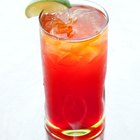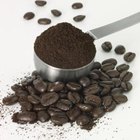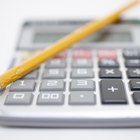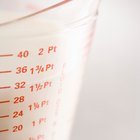
The long pour comes in handy when drinks need to be heavy on the liquor and light on the excuses. Long pouring refers to adding more alcohol to a drink than what is called for in its recipe. Perfecting your own long pour requires practicing different drink measurement methods, each one resulting in a heartier and more potent mixed drink.
Step 1
Add more alcohol to the mixed drink with a jigger. A jigger is a double-sided measurement device that looks like a hollow metal hourglass with one end larger than the other. The two ends measure two different amounts, with one end usually being one-half ounce to a full ounce larger than the other. Mastering the long pour with a jigger just means to use the larger opposite end instead of what is called for in the recipe. You don't have to fill the other end to the brim -- just more than the original end. The jigger's intended end can also be used twice for double the amount.
Step 2
Practice your free pour, then pour more. Free pouring means to pour alcohol from the bottle without any measuring cups while relying on a "count," which is the duration of time that a certain amount of liquid takes to pour. Take an empty liquor bottle, fill it up with water, affix a metal or plastic pour spout, and then pour the contents into an empty glass while counting. Start slow, and come up with your own counting system, like "one-Mississippi, two-Mississippi." Measure the amount of liquid with a jigger, and keep practicing. When you have your free pour down, then you can long pour by pouring longer.
Step 3
Add to the drink's entire volume by increasing all of its ingredients. This method of the long pour is akin to the classic double, which in most establishments is closer to 1.5 times more than the usual drink. Consult the drink's recipe and add more of each ingredient via jigger measurement, free pouring, or a measuring cup or spoon. The best long pours with this method need to equally increase the measurement of all the ingredients. If a drink requires 1 ounce of vodka, 1 ounce of triple sec, and 1 ounce of lime juice, increasing each ingredient by 0.5 or 1 ounce more will create a balanced cocktail.
Related Articles

How to Find Out How Many Cups Is 3 ...

How to Measure a Finger of Scotch

How to Calculate Punch for a Party

Proper Ratios on Mixed Drinks

How to Measure Coffee Grounds When ...

Can I Substitute Vodka for Rum in a ...

How to Calculate the ABV of a Mixed ...

How to Convert Gsm to Ounces

How to Measure a Cup of Water

What Are the Differences Among 24K, 22K ...

How to Extend a Toggle Clasp Bracelet

How to Measure the Acidity of Homemade ...

How to Make Espresso Using a Krups Il ...

How to Convert Fractions With Cooking
How to Make Mixed Drinks From Amaretto ...

What Kinds of Drinks Can You Make With ...

How to Make a White Russian Without ...

What Is a Good Mixed Drink Using ...

How to Make Frozen Mixed Drinks With ...

How to Add Chicory to Coffee
References
Tips
- Test your free pour every once in a while to ensure that your count is correct, and regularly clean your pour spouts.
Warnings
- Pouring long means more alcohol, so calculate that into your overall intake.
Writer Bio
Chance E. Gartneer began writing professionally in 2008 working in conjunction with FEMA. He has the unofficial record for the most undergraduate hours at the University of Texas at Austin. When not working on his children's book masterpiece, he writes educational pieces focusing on early mathematics and ESL topics.
Photo Credits
Comstock/Comstock/Getty Images